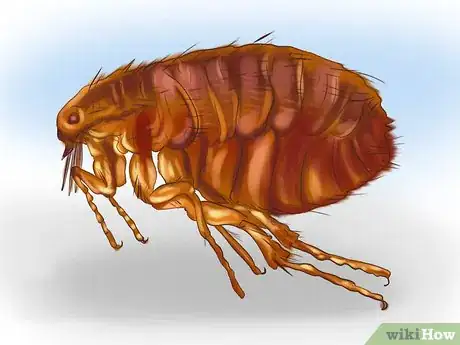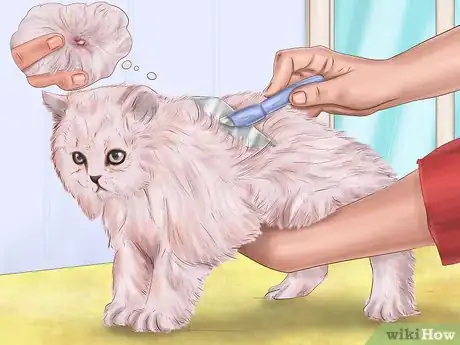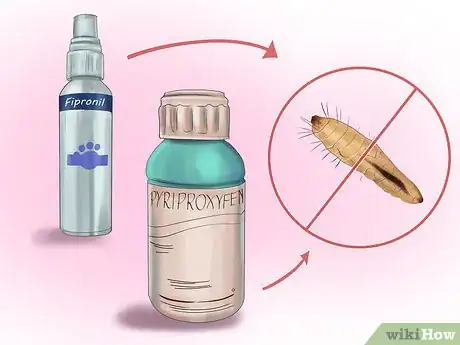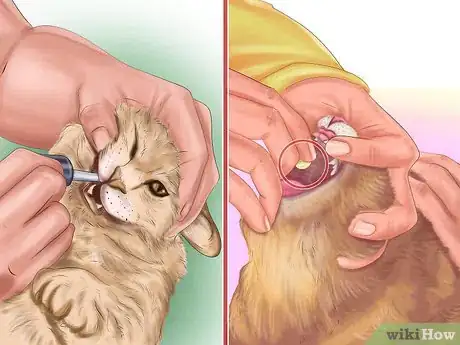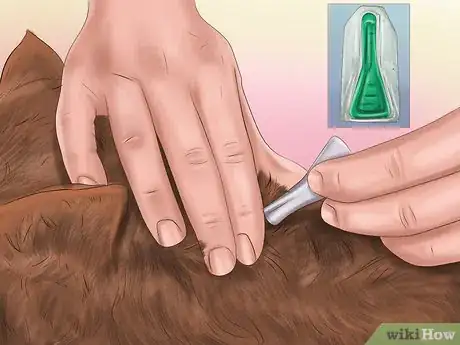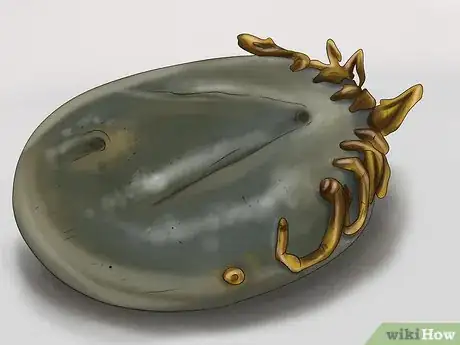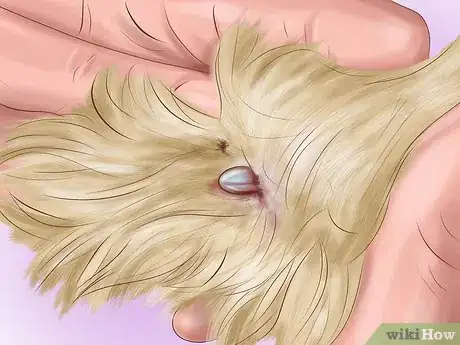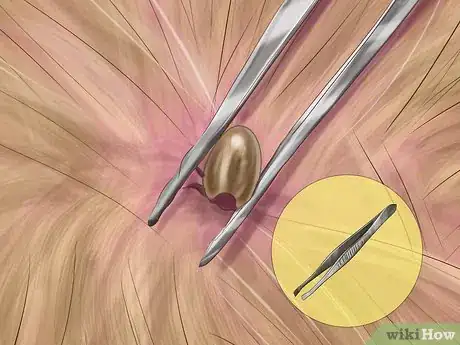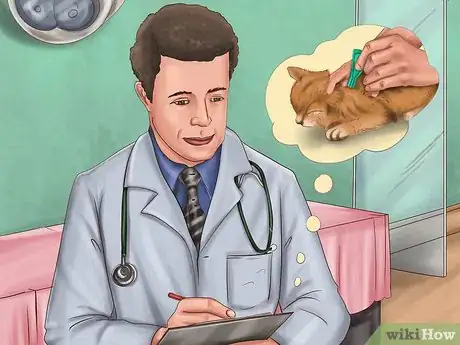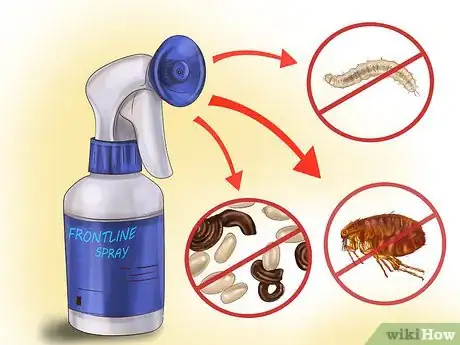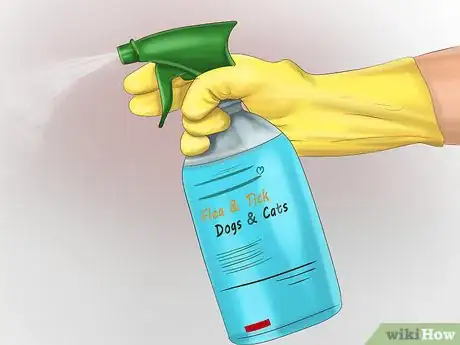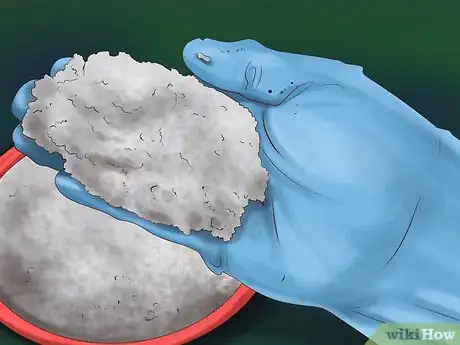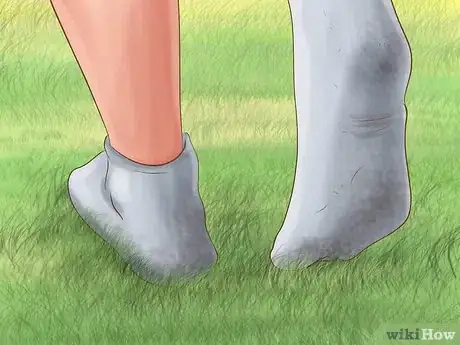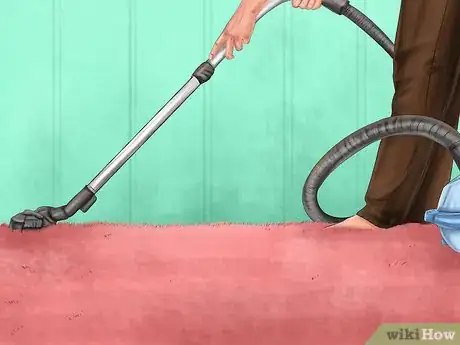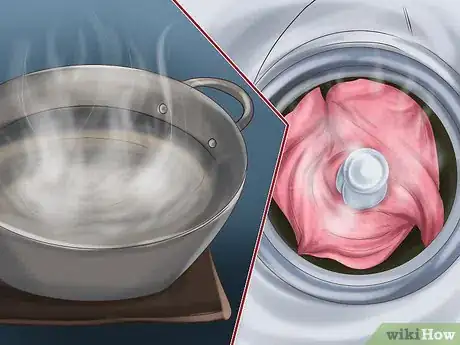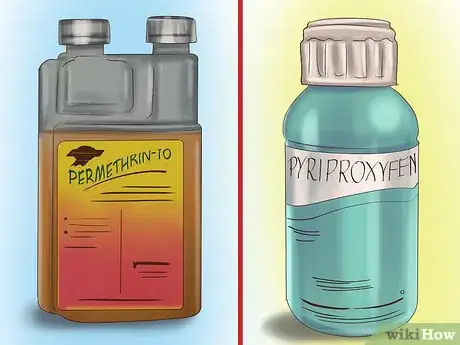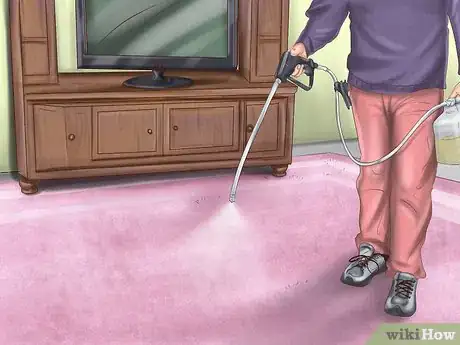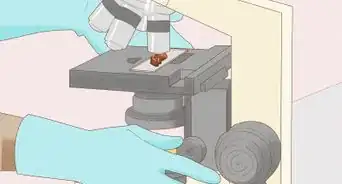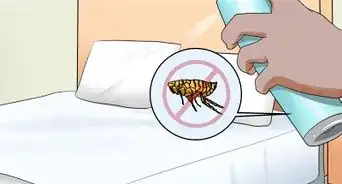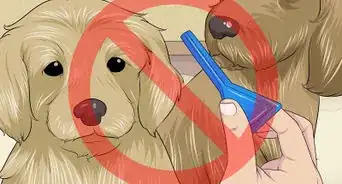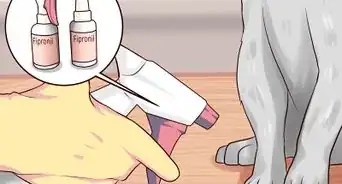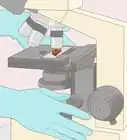This article was co-authored by Daniel Lioy-Ryan, PhD. Dr. Daniel Lioy-Ryan is an Animal Behaviorist and the Co-Founder of Cats in the City. With over a decade of experience, he specializes in understanding animal behavior, safely grooming cats, and working with cats at all life stages. Dr. Lioy-Ryan holds a PhD in Neuroscience from The Oregon Health & Science University.
There are 22 references cited in this article, which can be found at the bottom of the page.
wikiHow marks an article as reader-approved once it receives enough positive feedback. In this case, 98% of readers who voted found the article helpful, earning it our reader-approved status.
This article has been viewed 626,162 times.
Have you noticed your cat scratching her fur more than usual? Have you noticed little creatures crawling on your cat's skin? If so, they could be fleas or ticks. Unfortunately, if you've found them on your pet, they're most likely in your home too. Treatment is important, since these parasites feed on blood and can transmit harmful diseases to cats and humans. Learn how to identify fleas and ticks, then remove them from your pet, yard, and home.
Steps
Identifying and Killing Fleas on Your Cat
-
1Learn what fleas look like. Most people think that fleas are microscopic, but if you look closely you can see them without a magnifying class. Adult fleas are very small, less than 1⁄8 inch (0.3 cm) long. They're reddish-brown insects and they don't have wings, but they can still jump very high.[1]
- Fleas' bodies are laterally compressed, so their bodies are wider from back-to-belly than they are from side-to-side.[2]
-
2Look for signs of fleas on your cat. Take a fine-toothed comb and comb your cat's hair from back to front. Look at the skin for flea bites. Since fleas must bite in order to feed on blood, their bites will leave behind red, broken skin. You should also look for flea dirt, or poop. Once you've combed your cat, shake the flakes and specks of dirt out of the comb onto a white paper towel and add water. The flea dirt will become reddish brown, because it's made of digested blood. This is another sign that your cat has fleas.[3]
- If you are unsure if your cat has fleas, take her to your veterinarian. The veterinarian can identify the fleas and prescribe treatments to get rid of the parasites.
- Check your cat closely if she's been outside or somewhere where she may have been exposed to fleas (boarding facility, groomers, friend's house, motel, etc).
Advertisement -
3Talk with the veterinarian about flea medications. The vet will make sure that you choose a safe and effective product. You should also purchase flea treatments directly from your vet, since some of the medications sold at pet stores can be dangerous for cats.[4] Topical "spot-on" products are available to treat fleas, as well as oral medications.[5]
- Let the vet know if there are any small children or pregnant women in the home. This is an important factor in determining the safest course of medication for both you and your pet.
-
4Choose a spot-on medication. You may have several options when it comes to choosing a topical flea treatment. Many of these monthly treatments should be used year round as a preventative treatment. Make sure that the product you choose is labeled for cats and not dogs. Cats can get very sick (or even die) if they are treated with a flea medication that is meant for dogs. “Spot-on” treatments are applied directly to your cat’s skin to kill fleas quickly. Some common flea medications include:[6]
- Dinotefuran and pyriproxyfen (known as Vectra): This product only kills fleas. Be sure not to get a similarly named product, Vectra 3D, which is a product for dogs. Vectra 3D contains permethrin, which is harmful to cats.[7]
- Fipronil and (S)-methoprene (known as Frontline Plus for Cats): This product kills flea larvae, eggs, and adult fleas.[8] It also kills ticks and chewing lice.[9]
- Imidacloprid and pyriproxyfen (known as Advantage II): This product kills fleas of all life stages. Be sure not to get a similarly named product, Advantix II, which is a product for dogs. It contains permethrin, which is harmful to cats.[10]
- Selamectin (known as Revolution): Apply this once a month to kill adult fleas and their eggs. It also kills ticks, heartworms, ear mites, and sarcoptic mites. Be aware that Selamectin is not licensed as a product to kill ticks. It only has partial success with some ticks, and is not effective against Ixodes, which is the species which carries Lyme disease. If ticks are your main concern then speak to your veterinarian about more effective methods of control, such as a Seresto collar or Frontline.[11]
-
5Consider using an oral flea medication. If you're only trying to treat fleas and not ticks, you might think about giving your cat oral treatments, which may come as liquid suspensions or tablets. Oral products usually act quickly and don't leave any residue on your cat's fur.[12] They're only available through your vet, who can recommend the best product for your cat. Many of these monthly treatments should be used year round as a preventative treatment. These medications may include:[13]
- Lufenuron (known as Program): This comes as tablets, an oral suspension liquid, or injections. Give this medication with food once a month to kill flea eggs and larvae.[14]
- Nitenpyram (known as Capstar): This comes as a pill. Give it to your cat according to your veterinarian's directions to kill adult fleas and their eggs.[15] [16]
- Spinosad (known as Comfortis): This comes as chewable tablets, which you should give your cat with food once a month to kill fleas.[17]
-
6Correctly apply spot-on medication. Generally, you'll need to hold the applicator upright to keep it from spilling and open it according to the instructions. Spread the fur on your cat's neck (at the base of the skull or between the shoulder blades) to expose the skin. This way, your cat won't be able to lick the medication off when grooming. Turn the applicator upside down and squeeze all of the medication into a single spot directly on the skin. Make sure to get it on the skin and not just the fur. Check the applicator to make sure it's empty.[18]
- Always read the product label for complete instructions, since they are different for each medication.
Identifying and Killing Ticks on Your Cat
-
1Learn what ticks look like. Although different tick species have different characteristics, most ticks have an oval-shaped body with a small head. They're usually reddish brown, dark brown, black, or grey in color. Ticks are generally no bigger than 1⁄4 inch (0.6 cm) long and some species may be much smaller. Note that fully fed females can dramatically swell up to 1⁄2 inch (1.3 cm) in size when they're full of blood.[19] [20]
- Unlike fleas, ticks aren't insects. They're arachnids, like spiders, so the adults have 8 legs. The younger or smallest ticks (larvae) have 6 legs.
-
2Look for signs of ticks on your cat. Ticks can't jump or fly, so they crawl onto the host's body. When the tick bites your cat, it will stay firmly attached until it's done feeding. You won't be able to see the tick's head while it's feeding, which might make it hard to tell if you're looking at a tick or dark skin growth. To tell the difference, look for the tick's legs. Ticks also tend to accumulate in warm, protected areas of the body, like between the paw pads, in the ears, and armpits. However, they can be found anywhere on your cat’s body.[21] [22]
- If you are not sure whether the insect is a tick, you can place it in a completely sealed plastic bag and bring it to your cat’s veterinarian.
- Check your cat closely if she's been outside or somewhere where she may have been exposed to ticks (tall grassy fields, barns, farm, etc).
-
3Properly remove ticks. If you notice a tick on your cat, make sure that the object is in fact a tick. Look for the legs to be sure it's a tick and not just growth on your cat's skin. If it is a tick, put on gloves and grasp the tick with fine-tipped tweezers, as close to the skin as possible. Pull back slowly, taking care not to twist your hand. You need to remove the tick's head along with the body. If not, the head could cause infection. Put the tick into a small container filled with rubbing alcohol to kill and preserve it, in case you want to show it to the vet.[23]
- You should check your cat every day from head to tail for ticks if there's a tick infestation or your cat's been exploring areas where ticks live (like tall grassy fields).
-
4Talk with the veterinarian about tick medications. The vet will make sure that you choose a safe and effective product. You should also purchase tick treatments directly from your vet, since some of the medications sold at pet stores can be dangerous for cats. Topical "spot-on" treatments are available to treat fleas and ticks, while there are no oral products for treating ticks.[24]
- Let the vet know if there are any small children or pregnant women in the home. This is an important factor in determining the safest course of medication for both you and your pet.
-
5Choose a spot-on medication. You may have several options when it comes to choosing a topical tick treatment. Many of these monthly treatments should be used year round as a preventative treatment. Make sure that the product you choose is labeled for cats and not dogs. Cats can get very sick (or even die) if they are treated with a tick medication that is meant for dogs. Some common tick medications include:[25]
- Fipronil and (S)-methoprene (known as Frontline Plus for Cats): Apply this once a month to kill the larvae, eggs, and adult fleas. It also kills ticks and chewing lice.[26]
- Selamectin (known as Revolution): Apply this once a month to kill adult fleas and their eggs. It may also kill ticks, heartworms, ear mites, and sarcoptic mites, but it is not licensed as a product to kill ticks. It only has partial success with some ticks, and it not effective against Ixodes, which is the species that carries Lyme disease.[27]
-
6Correctly apply the spot-on medication. Generally, you'll need to hold the applicator upright to keep it from spilling and open it according to the instructions. Spread the fur on your cat's neck (at the base of the skull or between the shoulder blades) to expose the skin. This way, your cat won't be able to lick the medication off when grooming. Turn the applicator upside down and squeeze all of the medication into a single spot directly on the skin. Make sure to get it on the skin and not just the fur. Check the applicator to make sure it's empty.
- Always read the product label for complete instructions, since they are different for each medication.
-
7Ask your vet about other tick control options. Your vet may be able to recommend other options to keep ticks off your cat. One popular option is the Seresto collar, manufactured by Bayer. This collar can be used on kittens older than 10 weeks and adult cats. It repels and kills ticks for up to 8 months.[28]
- Other brands of tick collar exist. You should consult with your veterinarian to see what is recommended for your cat.
Eliminating Fleas and Ticks From Your Yard
-
1Keep your yard mowed and dry for effective tick control. Ticks thrive in moist, shady areas and tall grassy spaces. Cut your grass frequently to keep them from infesting your yard. You should also trim any low-lying bushes and rake up any decomposing leaves. This will remove shady and damp sections of your yard, which fleas and ticks love.[29]
- Making the environment (your yard) uninhabitable for them is key to preventing them from attaching to your pet.
- Keep moist compost piles away from the house and outdoor play areas, like sandboxes and decks.
-
2Create barriers for ticks. Ticks do not like crossing paths lined with wood chips, mulch, or gravel. Place these path materials around the edges of your yard to prevent ticks from approaching your yard and home. The barrier should be 3 feet (0.91 m) wide.[30]
- Don't be tempted to leave wood piles along the edge of your house. Instead, keep them stacked in the sun since messy wooded areas can actually attract ticks.[31]
-
3Block unwanted animals from entering your yard. Don't let animals like stray cats, rodents, and deer gain access to your yard. These animals may bring fleas and ticks into your yard. To keep them out, place bird feeders and wood piles away from your house, set up fencing, block crawl spaces, and plant trees and plants that discourage deer.[32]
- Plants that discourage deer include: boxwood, butterfly bush, ginkgo, and jasmine. Consult your local nursery for more planting ideas.
-
4Spray an Insect Growth Regulator (IGR). These treatments disrupt the fleas’ life cycle and keep them from reproducing. IGRs are considered safe for people and pets, but they are harmful to fish. Be careful if you're applying the regulator near a water source.[33]
-
5Spread diatomaceous earth around the yard. This natural product can be used in your garden to kill fleas, ticks, or insects. It works by dehydrating and shredding their bodies after they ingest the powder. Be cautious when applying it. Always wear gloves and purchase food grade diatomaceous earth. Sprinkle it around the yard where you've seen fleas or ticks.[34]
- Avoid touching diatomaceous earth with your hands, ingesting, or breathing it in. The very fine powder is actually very sharp and can irritate your skin or lungs, if you breathe it. When used correctly outdoors, it won't harm humans or pets.
-
6Use pesticides if you have found large numbers of fleas or ticks in your yard. To determine if you have fleas in your yard, you can walk around your yard in white socks that are pulled up to your knee. If there are fleas, you will be able to see them on your socks. You can call an experienced professional exterminator or talk to your vet about less expensive environmental pesticides you can buy. For fleas, you'll need to spray areas of the yard where your pet usually rests (such as a kennel or dog house), under decks, and next to the foundation. For ticks, spray moist and shady areas of the yard.[35]
- If you do a good job of treating your pets and protecting your yard from fleas and ticks, you may not need to treat your yard with pesticides.
- Never use Pyrethroid-, Permethrin-, or Amitraz-containing products on cats or in your yard. These products can cause severe side effects in cats, including death.
Eliminating Fleas and Ticks From Your Home
-
1Vacuum thoroughly. Vacuum carpets, rugs, and upholstered furniture daily to eliminate adult fleas, eggs and larvae.[36] Don’t forget to vacuum the carpet under your furniture. When vacuuming upholstered furniture, remove the cushions and vacuum all areas of the furniture, including all crevices. Afterwards, place the used vacuum bag in a sealed plastic bag and throw it away in an outdoor trash can.[37]
- The majority of the fleas in your house will be in the places where your pets sleep and rest. Concentrate your cleaning efforts in these areas. You should also clean the cracks and crevices around cabinets and baseboards every 1 to 2 days.
-
2Wash home fabrics and bedding. Wash your pet’s bedding and small rugs weekly in hot, soapy water.[38] You may also want to wash any pillow covers, pet bedding, human bedding, and other home fabrics as well. Washing in the hottest water will kill the flea eggs.
-
3Treat the rugs with an all-natural powder. Choose from baking soda, borax, or silica gel and sprinkle the powder over any rugs or carpeting in your house. Work the powder deep into the fibers of the carpet and let it sit overnight. The powder will dehydrate fleas that live in the fibers. Vacuum the powder up the next day and be sure to empty the vacuum canister or bag to an outside dumpster.[39]
- Keep any pets off of the rugs and carpets while there's powder spread on them. Only let them back on once the rugs are completely vacuumed and all the powder is removed.
-
4Choose an insecticide. Look for insecticides that contain insect growth regulators, like methoprene or pyriproxyfen. Check the label to make sure that the product can be used in households with cats. If you're not sure, ask a veterinarian before using it. Realize that insecticide sprays don't kill all stages of the flea's life cycle, so you may continue to see fleas for 2 weeks after you treat. Keep vacuuming during this time to keep flea numbers down.[40]
- Never use products that contain pyrethroid, permethrin, or amitraz. These can be lethal for cats.
-
5Apply the insecticide. Remove all people and pets from the room (including your cat, birds, or reptiles). Cover any fish tanks with plastic wrap and turn off tank aerators. Spray the insecticide directly onto areas where your pet sleeps. You can also spray carpets, rugs, furniture, baseboards, and windowsills. Don’t forget to spray the carpet under your furniture too.
- Keep all household members (including your pets) away from sprayed areas until the insecticide dries (usually within 24 hours). Opening your windows or turning on your air conditioning can improve ventilation and the drying time.
- Make sure to follow the instructions on the label of the insecticide for additional tips.
Expert Q&A
-
QuestionHow do I keep ticks and fleas from coming back?
 Pippa Elliott, MRCVSDr. Elliott, BVMS, MRCVS is a veterinarian with over 30 years of experience in veterinary surgery and companion animal practice. She graduated from the University of Glasgow in 1987 with a degree in veterinary medicine and surgery. She has worked at the same animal clinic in her hometown for over 20 years.
Pippa Elliott, MRCVSDr. Elliott, BVMS, MRCVS is a veterinarian with over 30 years of experience in veterinary surgery and companion animal practice. She graduated from the University of Glasgow in 1987 with a degree in veterinary medicine and surgery. She has worked at the same animal clinic in her hometown for over 20 years.
Veterinarian Treat the environment as well as the pet. This is to kill the flea eggs in the soft furnishings so they don't hatch out as the next generation of adult fleas.
Treat the environment as well as the pet. This is to kill the flea eggs in the soft furnishings so they don't hatch out as the next generation of adult fleas.
Warnings
- Learn which chemicals to avoid. Organophosphate compounds (OCs), like tetrachlorvinphos, are used in some flea treatment medicines. They have been labeled "likely carcinogenic to human" by the EPA and should be avoided.[41]⧼thumbs_response⧽
References
- ↑ http://www.banfield.com/pet-health-resources/preventive-care/parasites/fleas/how-to-identify-fleas-on-your-pet
- ↑ http://www.banfield.com/pet-health-resources/preventive-care/parasites/fleas/how-to-identify-fleas-on-your-pet
- ↑ http://www.banfield.com/pet-health-resources/preventive-care/parasites/fleas/how-to-identify-fleas-on-your-pet
- ↑ Daniel Lioy-Ryan, PhD. Animal Behaviorist. Expert Interview. 17 August 2021.
- ↑ Stafford, KC. Tick Management Handbook: An integrated guide for homeowners, pest control operators, and public health officials for the prevention of tick-associated disease. The Connecticut Department of Public Health. http://www.ct.gov/caes/lib/caes/documents/special_features/tickhandbook.pdf
- ↑ How to Manage Pests: Pests of Homes, Structures, People, and Pets. Fleas. Revised 9/10. http://www.ipm.ucdavis.edu/PMG/PESTNOTES/pn7419.html
- ↑ http://www.drugs.com/vet/vectra-for-cats-kittens.html
- ↑ Daniel Lioy-Ryan, PhD. Animal Behaviorist. Expert Interview. 17 August 2021.
- ↑ http://www.drugs.com/vet/frontline-plus-for-cats-kittens.html
- ↑ http://www.drugs.com/vet/advantage-ii-kitten.html
- ↑ http://www.drugs.com/vet/revolution.html
- ↑ Daniel Lioy-Ryan, PhD. Animal Behaviorist. Expert Interview. 17 August 2021.
- ↑ Potter M. Ridding Your Home of Fleas. http://www2.ca.uky.edu/entomology/entfacts/ef602.asp Accessed June 25, 2015.
- ↑ http://www.peteducation.com/article.cfm?c=26+1303&aid=1471
- ↑ Daniel Lioy-Ryan, PhD. Animal Behaviorist. Expert Interview. 17 August 2021.
- ↑ http://www.drsfostersmith.com/Rx_Info_Sheets/rx_nitenpyram.pdf
- ↑ http://www.drugs.com/vet/comfortis-chewable-tablets-for-cats.html
- ↑ http://www.drugs.com/vet/vectra-for-cats-kittens.html
- ↑ Stafford, KC. Tick Management Handbook: A integrated guide for homeowners, pest control operators, and public health officials for the prevention of tick-associated disease. The Connecticut Department of Public Health. http://www.ct.gov/caes/lib/caes/documents/special_features/tickhandbook.pdf
- ↑ Ticks Around Your Home. Clemson University. http://www.clemson.edu/cafls/departments/esps/factsheets/medvet/ticks_around_your_home_mv05.html
- ↑ Stafford, KC. Tick Management Handbook: A integrated guide for homeowners, pest control operators, and public health officials for the prevention of tick-associated disease. The Connecticut Department of Public Health. http://www.ct.gov/caes/lib/caes/documents/special_features/tickhandbook.pdf
- ↑ Ticks Around Your Home. Clemson University. http://www.clemson.edu/cafls/departments/esps/factsheets/medvet/ticks_around_your_home_mv05.html
- ↑ http://www.aspca.org/pet-care/cat-care/ticks
- ↑ Stafford, KC. Tick Management Handbook: A integrated guide for homeowners, pest control operators, and public health officials for the prevention of tick-associated disease. The Connecticut Department of Public Health. http://www.ct.gov/caes/lib/caes/documents/special_features/tickhandbook.pdf
- ↑ How to Manage Pests: Pests of Homes, Structures, People, and Pets. Fleas. Revised 9/10. http://www.ipm.ucdavis.edu/PMG/PESTNOTES/pn7419.html
- ↑ http://www.drugs.com/vet/frontline-plus-for-cats-kittens.html
- ↑ http://www.drugs.com/vet/revolution.html
- ↑ https://www.drugs.com/vet/seresto-cat.html
- ↑ How to Manage Pests: Pests of Homes, Structures, People, and Pets. Fleas. Revised 9/10. http://www.ipm.ucdavis.edu/PMG/PESTNOTES/pn7419.html
- ↑ How to Manage Pests: Pests of Homes, Structures, People, and Pets. Fleas. Revised 9/10. http://www.ipm.ucdavis.edu/PMG/PESTNOTES/pn7419.html
- ↑ http://www.popularmechanics.com/home/improvement/lawn-garden/6-simple-tips-to-get-rid-of-ticks#slide-1
- ↑ Preventing Ticks in the Yard. http://www.cdc.gov/ticks/avoid/in_the_yard.html
- ↑ https://www.petcarerx.com/article/how-to-treat-fleas-in-the-yard/161
- ↑ https://www.petcarerx.com/article/how-to-treat-fleas-in-the-yard/161
- ↑ Preventing Ticks in the Yard. http://www.cdc.gov/ticks/avoid/in_the_yard.html
- ↑ Daniel Lioy-Ryan, PhD. Animal Behaviorist. Expert Interview. 17 August 2021.
- ↑ Ticks Around Your Home. Clemson University. http://www.clemson.edu/cafls/departments/esps/factsheets/medvet/ticks_around_your_home_mv05.html
- ↑ Daniel Lioy-Ryan, PhD. Animal Behaviorist. Expert Interview. 17 August 2021.
- ↑ http://atlantahumane.org/education-center/fleas-ticks/
- ↑ Ticks Around Your Home. Clemson University. http://www.clemson.edu/cafls/departments/esps/factsheets/medvet/ticks_around_your_home_mv05.html
- ↑ http://www.petmd.com/cat/parasites/evr_ct_fleas_on_cats_tick_preventive_medication_for_dogs#.Ulhfl2Q9xgI
About This Article
To kill fleas and ticks on your cat, start by choosing a spot-on medication specifically made for cats that kills both fleas and ticks, like Frontline Plus for Cats. Next, spread your cat’s fur at the base of its skull and apply the medication using the pre-measured applicator on a single spot directly on its skin. If the medication is a year-round preventative treatment, continue administering it once a month, or as frequently as the medication specifies. For more tips from our Veterinary reviewer, like how to get rid of fleas and ticks from your home, read on!
